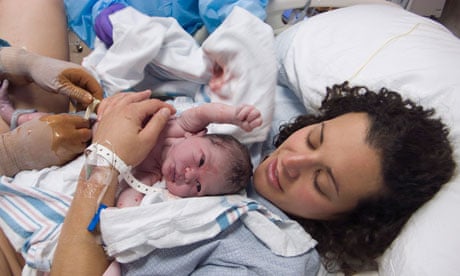Hospitals are under pressure to stop clamping newborn babies' umbilical cords after new research found that their health improves if the cord is left to pulse for several minutes.
Cutting the cord too early denies babies an important supply of blood and can also reduce the amount of iron a newborn receives, according to a study by the highly-respected Cochrane Library of medical researchers.
Although it is standard practice to do that, there are "some potentially important advantages of delayed cord clamping in healthy term infants, such as higher birthweight, early haemoglobin concentration, and increased iron reserves up to six months after birth", the researchers concluded.
Their review of 15 previous studies, involving 3,911 women and their babies, found no evidence to support the longstanding rationale for the practice, that it reduces a mother's risk of experiencing severe bleeding after giving birth, called postpartum haemorrhage. The risk is the same with both policies, they found.
The NHS is now facing calls to rethink a policy that has been standard for about 50 years. The medical royal colleges representing obstetricians and gynaecologists and midwives, as well as the NCT childbirth and parenting charity, want hospitals to switch to routinely delaying clamping for several minutes.
Most NHS maternity units still clamp the cord as soon as the child is born, though the growing evidence in favour of delayed clamping has prompted a number of hospitals to adopt that approach in recent years. Several changed their procedures after the Guardian in April highlighted rising concern that babies' health may be suffering as a result. Critics of immediate clamping say hospitals feel bound by guidance produced in 2007 by the National Institute of Health and Care Excellence (NICE), which recommended "early clamping and cutting of the cord" for active management of the third stage of labour, the delivery of the baby.
Belinda Phipps, chief executive of the NCT, said that if fewer babies had their cord clamped right away, fewer of them would end up needing special care in their first few days of life for breathing difficulties. "As is explained in this research, when a baby is born around a third of the baby's blood is still in their cord and placenta, and clamping the cord early reduces the iron available to the baby. It is becoming increasingly clear that things need to change", she said.
Prompted by increasing evidence showing that approach may be unwise, NICE is now reviewing it but will not produce draft updated guidance until May 2014, and final guidance until autumn next year. Professor Mark Baker, Director of NICE's centre for clinical practice, said: "Our priority is to ensure that mothers and babies get the best possible care. All available evidence on the right time to clamp a new born baby's cord is being considered and recommendations will be based on the best available, published evidence. Our guideline for the NHS will represent best possible practice and will put mother and baby's safety first."
However, the Cochrane study also warns that babies who experience delayed cord clamping may be at slighly higher risk of becoming jaundiced. More maternity units would need to be able to give babies phototherapy, to reduce jaundice, if the NHS does adopt a routine position of delaying clamping, said Patrick O'Brien, a spokesman for the Royal College of Obstetricians and Gynaecologists.
While it backed delayed clamping, "in some instances early clamping may be required, such as when the mother is suffering heavy blood loss immediately after childbirth, or in cases where the baby needs immediate resuscitation, so the decision on when to cut the cord must be based on the clinical assessment of the situation", O'Brien added.
